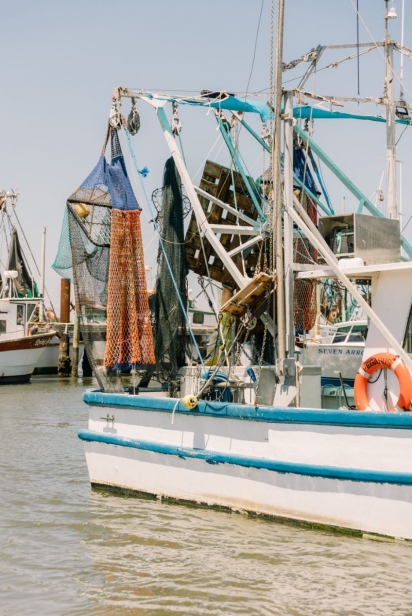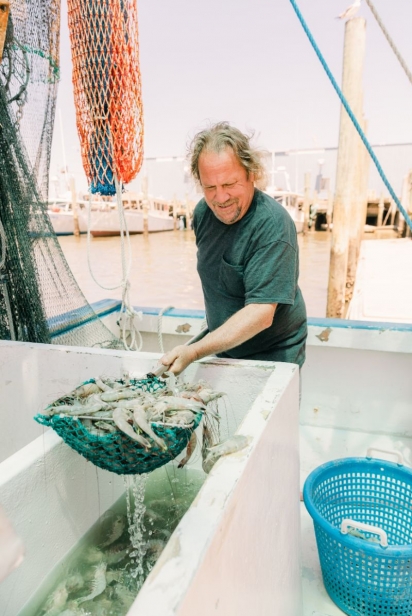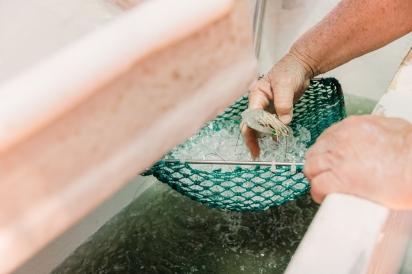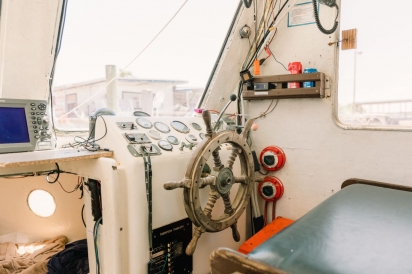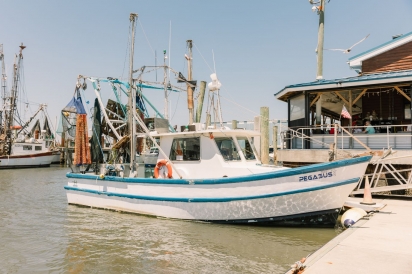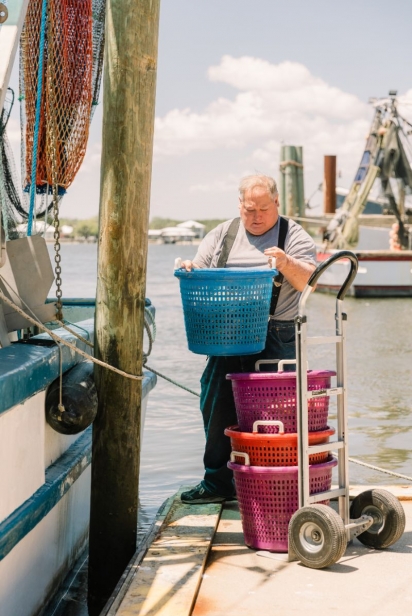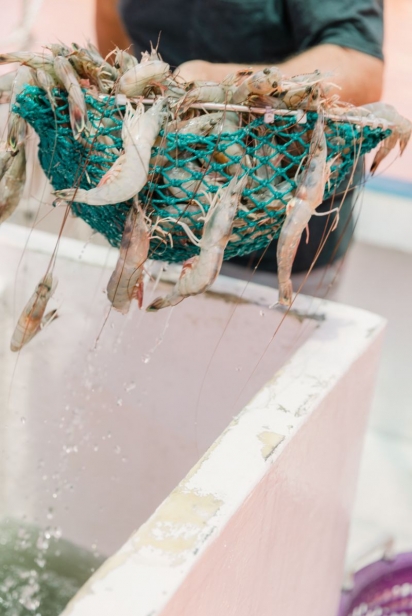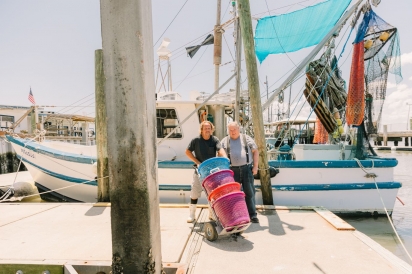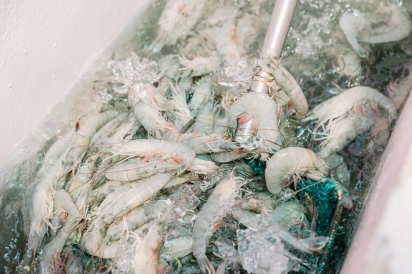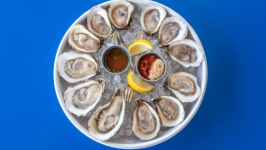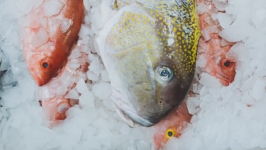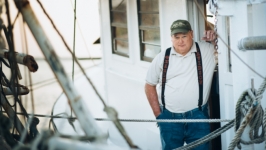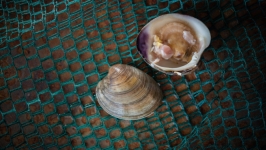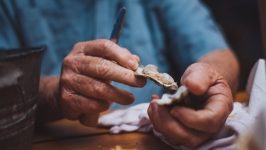Shrimp Boats Are A-Coming
Shrimp have been part of the human story of Northeast Florida ever since the first people threw the first cast nets into our waters thousands of years ago. The region’s taste for the savory crustaceans has only grown over time, and in fact it’s here on the First Coast that fisherfolk revolutionized shrimping as a commercial enterprise. Fernandina shrimpers were the first to use motorboats, enabling them to travel farther out to sea and discover one of the most productive shrimp fisheries known at the time, just off our shores. They also pioneered the otter trawl for shrimping, still the industry standard to this day.
The waters of the First Coast boast such bounty because the St. Johns River watershed is a veritable shrimp superhighway. Young shrimp hatch and mature in the river system before heading out to the open ocean, playing a critical role in the ecosystem and food web in every stage of life. Shrimp in Northeast Florida are said to be especially delicious because of the abundant food sources to be found where the St. Johns meets the sea.
Jacksonville and St. Augustine quickly followed Fernandina’s lead to become shrimping meccas, with Mayport in particular emerging as a hub for offloading and distributing shrimp. This led to “Mayport shrimp” becoming a byword for the fresh shrimp purveyed there. Although the term has been ubiquitous since the 1960s, it has caused some confusion. “Mayport shrimp” aren’t necessarily caught in the Mayport area – local shrimpers follow their quarry wherever it goes, so shrimp offloaded in Mayport may have come from as far away as the Carolinas or the Florida Keys. Additionally, with the decline of Mayport’s shrimp docks, local shrimpers may offload elsewhere in the region, but the shrimp are just as delicious. And of course, unscrupulous restaurants and vendors may label something “Mayport shrimp” that has no connection to the region at all. Perhaps a fairer definition for authentic Mayport shrimp would include any caught wild in the South Atlantic fishery and sold fresh here in Northeast Florida.
Mayport and Fernandina have declined as shrimping ports due to a loss of commercial dock space and the influx of imported, farm-raised shrimp, which undercuts profit margins while supplying a vastly inferior product. Nonetheless, shrimping remains a significant local industry. According to the Florida Fish And Wildlife Conservation Commission, in 2022 Jacksonville took in 1.5 million pounds of shrimp, contributing $3.9 million to the local economy. St. Augustine was even more productive, taking in 2 million pounds for an economic impact of $5.4 million. Together, the cities accounted for 18% of all shrimp caught in Florida, making this the second biggest shrimp-producing region in the state after only the famously prolific Tortugas pink shrimp fishery west of the Florida Keys.
Several species of shrimp are caught in Northeast Florida, with the most common by far being the white shrimp, Litopenaeus setiferus. In 2022, whites accounted for fully 73.2% of the shrimp harvest in Northeast Florida. As the name implies, white shrimp are light in color with a blue-green tinge when caught. They become light pink when cooked and are known for their tender texture and somewhat sweet flavor.
Accounting for 12.8% of the haul, the second most-caught shrimp in Northeast Florida in 2022 was the rock shrimp, Sicyonia brevirostris. Also known as hardheads, these shrimp are found in deeper waters than the other common varieties. Once considered “trash fish,” they were rarely pursued before the 1970s, due to their hard-to-crack shells and the difficulty of finding and harvesting them. Once Floridians figured out how to eat them – and how delicious they are – their reputation steadily increased. They have a firm texture and a sweet, lobster-like flavor.
Brown shrimp, Farfantepenaeus aztecus, made up 11.1% of the local catch last year. These shrimp are a reddish-brown color and are typically smaller than white shrimp. They have a fairly firm texture and their flavor is mild though often especially “shrimpy” due to the iodine in their bodies from the algae they eat.
Less commonly caught species include royal red shrimp, Pleoticus robustus. These small, red shrimp are found in the deepest waters roughly between Jacksonville and Cape Canaveral, so harvesting them requires different equipment. Though they made up only 1% of the 2022 shrimp haul in Northeast Florida catch, this was the most productive region in the state for harvesting because of the relatively cold Atlantic waters this far north. The catch of pink shrimp, Farfantepenaeus duorarum, was even smaller. These shrimp are common in South Florida and the Gulf of Mexico, but make up only a small fraction of the shrimp caught on the First Coast.
Shrimping in North Florida may not be what it was when hundreds of boats patrolled the waters from local docks, but the shrimpers who remain are providing something that can never be replaced by the low-quality stock of foreign factory farms. Still, the demand for fresh, local shrimp is palpable and growing every year. Serious reinvestment in the docks and facilities of Mayport, St. Augustine and Florida’s other shrimping towns – and perhaps stronger labeling rules – may be the ticket to a true shrimp revival.



